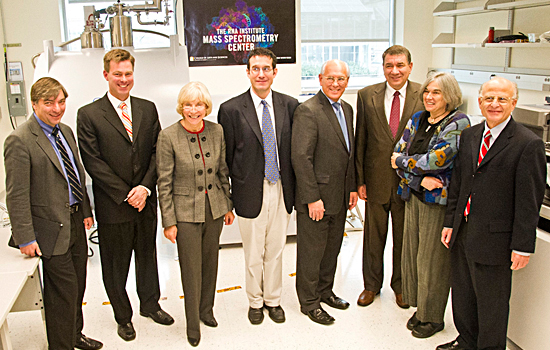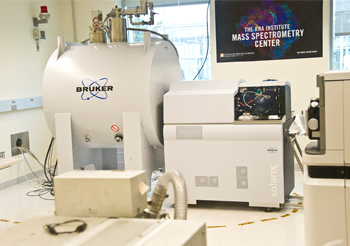$7.4M in New Awards Propels UAlbany RNA Institute
$5.37 million NIH American Recovery and Reinvestment Act grant, plus $2 million in NYS matching funds, moves New York State into leadership role as resource for RNA-based drug discovery

Gathered in the new Mass Spectrometry Center at The RNA Institute are, from left: Bruker Daltonics Vice President Gary Kruppa, Krackeler Scientific President Tony Krackeler, UAlbany College of Arts and Sciences Dean Elga Wulfert, MassSpec Center Director Dan Fabris, Congressman Paul Tonko, UAlbany President George Philip, National Academy of Science member and Distinguished Professor Marlene Belfort, and The RNA Institute Director Paul Agris.
ALBANY, N.Y. (November 05, 2010) --
A $5.37 million grant from the National Institutes of Health/National Center for Research Resources (NIH/NCRR) and $2 million in matching funds from the State of New York will advance The RNA Institute at the University at Albany to serve as the leading national resource for RNA research. The Institute is dedicated to the advancement of RNA science and technologies and drug discovery.
The funding will finance the design, engineering and construction of a research center similar to those found in modern pharmaceutical companies, with open, interactive space to promote collaboration and synergies, and sustainability built into the complete mobility of laboratory benches and walls. This sustainability will accommodate changes in RNA science and techniques for years to come.
"This critical funding will help The RNA Institute attract foremost scientists and generate more than 90 permanent jobs," said UAlbany President George M. Philip. "By doing so, it will further The Institute's goal of moving New York State into a leadership role as a national resource for RNA-based drug discovery."
Today, UAlbany also unveiled the installation of its new RNA Mass Spectrometry (MassSpec) Center, which will provide additional impetus for early phase, novel RNA-based drug discovery.
An Enhancement to the Capital Region's R&D Community
Launched on June 4 of this year, UAlbany's RNA Institute is leveraging a new paradigm in drug discovery with the development and delivery of RNA-based therapeutics to treat infectious disease, various cancers, neurodegenerative disorders, and other illnesses, including orphan diseases.
The NIH/NCRR grant is infused by funds from the federal American Recovery and Reinvestment Act and will be complemented by $2 million in SUNY capital funding.
"These Recovery Act funds to UAlbany's RNA Institute will help create an ideal environment for scientists in the emerging field of RNA research to accelerate research to improve health," said NIH/NCRR Director Barbara Alving, M.D.
NCRR is a component of NIH that supports primary research to create and develop critical resources, models, and technologies.
"This federal investment in the University at Albany will help The RNA Institute move forward with cutting edge research and development that could lead to exciting new discoveries in the treatment of disease," said Congressman Paul Tonko (NY-21). "Congratulations to UAlbany for putting together a public-private partnership that has great potential to grow into an economic engine for the Capital Region."
 |
The Bruker 12 Tesla mass spectrometer, the latest piece of instrumentation to enhance The RNA Institute's MassSpec Center |
The RNA Institute Director Dr. Paul F. Agris noted, "in this tough economic environment, peer reviewed validation of RNA-based drug discovery and NIH financial support for the Institute's vision are incredibly exciting for the UAlbany research community and for the greater Capital Region."
See RNA-related story from November 10, 2008, New York Times.
The unique combination of scientific and educational infrastructure and flexible space will fully transform The Institute's home, UAlbany's Life Sciences Research Center, into a Leadership in Energy and Environmental Design (LEED)-Silver certified facility. A major component of the renovation will be the installation of a heat-recovery system, valued at approximately $1 million.
"The project will incorporate many green and sustainable features, including heat recovery, day-lighting and solar control, which will provide energy savings and promote a high quality of design within the research space," said David Radzyminski, project manager for UAlbany's Office of Architecture, Engineering, & Construction Management.
"The design also includes two other elements of modern research centers: mobile and flexible laboratory bench and wall systems to provide a sustainable and efficient method of accommodating changes in RNA science and techniques for years to come, and the use of open and interactive spaces that will promote research collaboration and synergies."
Reaction from New York Political and Educational Leaders
"This project is a win–win for the Capital Region," said New York Senator Charles Schumer. "It creates jobs in a cutting-edge scientific field while making important breakthroughs that can improve and extend people's lives. And, the University at Albany has already shown that it can create good paying jobs through its high tech research. The RNA Institute holds the promise of creating jobs in biosciences just as they have in nanotechnology. This federal support will help to drive investment and speed up our economic recovery."
"It is critical that we invest in the life-saving research and technologies at our education institutions across New York," said New York Senator Kirsten Gillibrand. "These federal dollars will help deliver cutting-edge medical research that could be critical to diagnosis and treatment. I will continue to fight for investments such as this one, which will help us achieve our state's full economic potential, by fostering opportunity and innovation at our colleges and universities."
"This NIH grant recognizes that some of the best researchers in the world are right here in New York State, working on highly innovative ventures," said SUNY Chancellor Nancy L. Zimpher. "The RNA Institute will create a comprehensive development chain, from research and development through commercialization, that will foster jobs and industry growth and have a strong impact on the economic revitalization of the state."
The NIH/NCRR implementation timeline for the project calls for an architectural design to be submitted to the NIH for approval this month, construction bids to go out in April 2011, and construction to begin next July. Scheduled completion of construction is July 2012. It is estimated that 40 short-term construction jobs will be created by the project.
"This award provides a significant stimulus to the University's public-private partnerships," said President Philip. "More and more companies will take notice of The RNA Institute's work and wish to join in collaborative research and development efforts. That, in turn, will grow the Institute as an economic engine for the region and state."
MassSpec Center also Unveiled
Another indication of the Institute’s growing profile in the field of RNA-based research is the establishment of the RNA MassSpec Center, dedicated to the development of MassSpec-based technologies for investigating the structure-function relationships of natural and synthetic RNA as tools for drug discovery.
"The mission and vision of the Institute is to develop the means for addressing very difficult human diseases through novel technologies and RNA-based drug discovery," said Agris. "The RNA MassSpec Center is the first comprehensive facility directed at the structure-function relationship of RNA, which is critically important for drug discovery."
Video: new Bruker 12 Tesla mass spectrometer arrives at the MassSpec Center, 10-21-10.
Dan Fabris, UAlbany professor of chemistry and biology and director of the RNA MassSpec Center, noted: "Mass spectrometry presents an enormous untapped potential for RNA biomedical research. The world-class instrumentation concentrated here will allow us to tap this potential and obtain critical information not accessible by any other technique. These unique capabilities will place the RNA MassSpec Center at the leading edge of the development of new enabling technologies and that will provide the opportunity for many fruitful collaborations with RNA scientists worldwide."
In conjunction with scientific discovery and research, the Institute offers resources for small, medium and large biomedical businesses to spur the development of start-up companies, new R&D centers, and related business operations through public-private partnerships. In collaboration with UAlbany's School of Business, the Institute offers tools and strategies to researchers for assessing the marketplace and successfully developing and commercializing novel technologies in the Capital Region.
"I am very excited that NCRR and the National Institutes of Health have awarded this construction grant to UAlbany in support of the College of Arts and Science's vision of The RNA Institute as a premier interdisciplinary research and training facility," said Edelgard Wulfert, dean of the College of Arts and Sciences. "Our grant proposal was selected for funding in a competitive process and based on rigorous peer-review from among a large pool of proposals coming from the best institutions in the country."
The RNA Institute comprises more than 40 principal university and government research entities whose work has generated more than 250 grant-funded staff positions in New York's Capital Region. The RNA Institute-affiliated researchers in the Capital District are currently receiving approximately $12 million per year in federal grant funding.
![]() For more news, subscribe to UAlbany's RSS headline feeds
For more news, subscribe to UAlbany's RSS headline feeds
Educationally and culturally, the University at Albany-SUNY puts "The World Within Reach" for its 18,000 students. An internationally recognized research university with 58 undergraduate majors and 128 graduate degree programs, UAlbany is a leader among all New York State colleges and universities in such diverse fields as public policy, nanotechnology and criminal justice. With a curriculum enhanced by 300 study-abroad opportunities, UAlbany launches great careers. For more information about this globally ranked University, visit https://www.albany.edu/. For UAlbany's extensive roster of faculty experts, visit www.albany.edu/news/experts.shtml.



